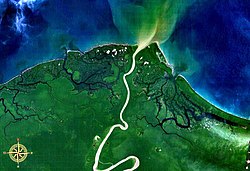Mamberamo River
| Mamberamo | |
| River | |
|
Mamberamo entering the sea, seen from space.
|
|
| Country | Indonesia |
|---|---|
| Region | Papua |
| Source | confluence of Tariku and Taritatu |
| - coordinates | 2°55′30″S 138°26′30″E / 2.92500°S 138.44167°E |
| Mouth | |
| - location | Pacific |
| - coordinates | 1°28′S 137°54′E / 1.467°S 137.900°ECoordinates: 1°28′S 137°54′E / 1.467°S 137.900°E |
| Discharge | |
| - average | 4,580 m3/s (161,740 cu ft/s) |
The Mamberamo is a large river on the island of New Guinea, in the Indonesian province of Papua. It is the largest river in Indonesia by volume of discharge, and also the widest.
The source of the river is formed from the confluences of its upper tributaries, the Tariku and Taritatu Rivers. From there it flows northwards in a great valley through the Van Rees Range (Pegunungan Van Rees), to reach the lowland marshes of its broad river delta. The Mamberamo discharges into the Pacific Ocean at the northern point of Point D'Urville (Tanjung D'Urville).
The river's huge valley is home to various uncontacted peoples and incredible biodiversity. In the 1990s, the Indonesian Government had plans to construct a large hydroelectric dam on the Mamberamo that would have submerged much of the area. This plan was shelved after the Indonesian financial crisis from 1998–1999, but there are concerns by environmental groups that it could be resurrected sometime in the future. At present, the Mamberamo remains the second largest river in the world to be completely unfragmented by dams in its catchment, behind only the relatively nearby Fly.
The Mamberamo area also broadly refers to several nearby mountain ranges, including the Van Rees and Foja Mountains (also known as Foya), which were the subject of a recent rapid biological assessment conducted by Conservation International, the Indonesian Institute of Sciences, and Cenderawasih University. The scientific team discovered the first new bird species from New Guinea in 60 years, and a wealth of other new plants and animals. The Foya Mountains appear to be a globally outstanding repository of biodiversity.
...
Wikipedia

